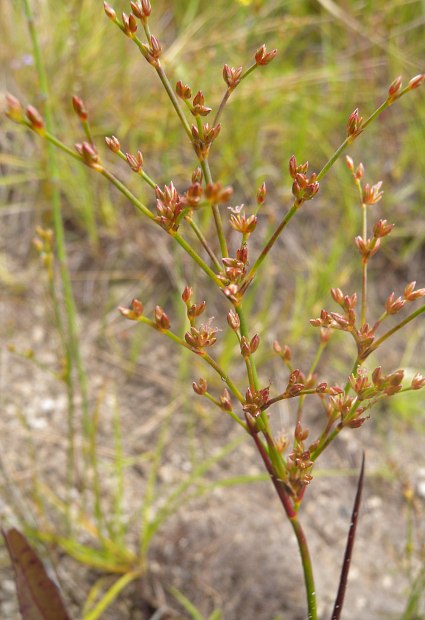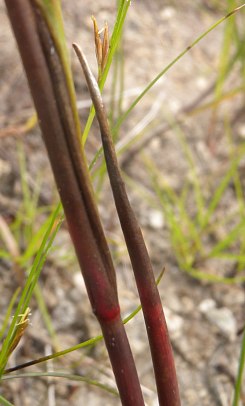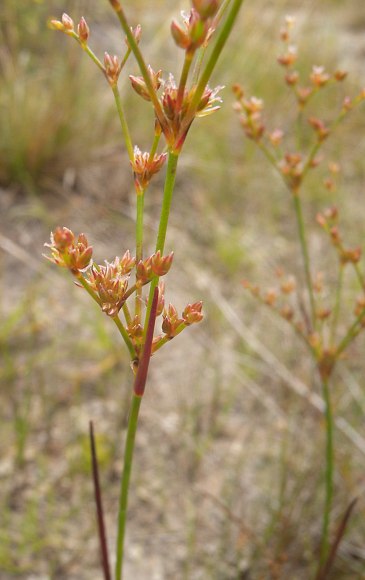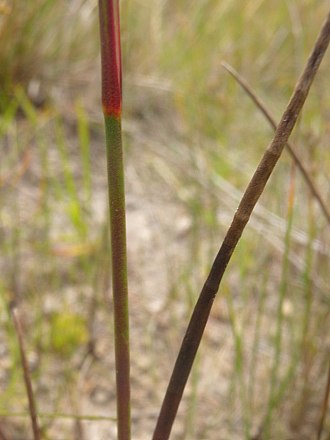
The branches of the inflorescence are ascending, divergent, and either straight or slightly arching; they are light green to reddish green, hairless, and variable in length. There are 1-7 divergent-ascending branches (often only 1 branch) per node of the inflorescence. The branches of the inflorescence terminate in either a cluster of flowers or another panicle of clustered flowers. Individual clusters have 2-5 flowers and they are about 3-6 mm. across. Depending on the stage of development and exposure to sunlight, these clusters of flowers are yellowish green, pinkish green, orange-red, or reddish brown. Each flower has 3 outer tepals and 3 inner tepals that are 2–2.5 mm. long; they are erect or erect-appressed, lanceolate in shape, narrowly membranous along their margins, and scale-like in appearance. The inner tepals are usually slightly longer than the outer tepals. In addition to the tepals, each flower has a lanceoloid-ellipsoid ovary that is 2.5–4 mm. long and 3-angled; it is longer than the surrounding tepals. Each flower usually has 3 stamens with yellow anthers (rarely 6 stamens) and a feathery tripartite stigma that is white or light red. Small scale-like bractlets occur at the base of each cluster of flowers. The base of the inflorescence has a larger leafy bract that is ½–4" long. The blooming period occurs from mid-summer to early autumn, lasting about 2 weeks for a colony of plants. The flowers are cross-pollinated by the wind.

Afterwards, the ovaries mature into seed capsules. These seed capsules divide into 3 parts to release numerous tiny seeds that can be blown about by the wind or be carried by water. Individual seeds are 0.75–1 mm. long, narrowly ellipsoid-oblongoid in shape, somewhat flattened, and short-tailed at their tips. There are 20-40 fine longitudinal ribs on each seed that are finely cross-veined. Sometimes more than one leafy stem develops from the crown of shallow roots.
Cultivation: The preference is full or partial sun, wet conditions, and calcareous soil containing marl or sand.
Range & Habitat: The native Small-headed Rush (Juncus brachycephalus) is occasional in NE Illinois, while in the rest of the state it is either uncommon or absent (see Distribution Map). Habitats include marly gravel pannes, calcareous seeps, wet meadows in fens, areas along beach pools, and spring-fed ponds. In Illinois, this rush occurs in high quality wetland areas that are calcareous.

Faunal Associations: Insects that feed on rushes (Juncus spp.) include the larvae of leaf-mining flies (Cerodontha spp.), the larvae of moths (various species), aphids (various species), seed bugs (Cymodema spp.), and others (see the Insect Table for a more complete list of these species). Vertebrate animals use rushes as a food source only to a limited extent as the foliage is usually tough and stringy and the seeds are tiny. However, it has been reported that the Green-winged Teal and Greater Prairie Chicken sometimes feed on the seed capsules of these plants, and the Muskrat feeds sparingly on the root crowns (Anderson, 1959; Schwartz, 1945; Hamerstrom & Blake, 1939). The tiny seeds may cling to the fur of passing mammals and to the feathers of birds. By this means, the seeds of rushes are probably transported from one wetland to another.
Photographic Location: A marly gravel panne of a fen at a nature preserve in Lake County, Illinois.

Comments: This medium-small rush is a fairly typical example of the many native rushes (Juncus spp.) that occur in Illinois. It is larger in size than Jointed Rush (Juncus articulatus) and usually has more clusters of flowers (or seed capsules) per inflorescence. At one time, Small-headed Rush (Juncus brachycephalus) was considered a variety of Canada Rush (Juncus canadensis), but this latter species is somewhat larger in size, it has larger clusters of flowers, and its seeds have longer tails. Small-headed Rush can be distinguished from other similar species by its hollow leaves, obpyramidal panicles of clustered flowers, relatively few flowers per cluster (2-5), ovaries (or seed capsules) that are longer than the tepals, tapered acute tips of the ovaries (or seed capsules), and the presence of 3 stamens rather than 6 per flower (usually). Small-headed Rush tends to have more colorful leaf blades and flower clusters than most rushes that I have seen.